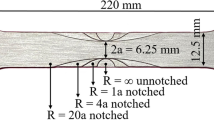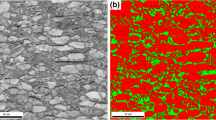Abstract
This paper presents a physics-based model able to simulate the flow stress behavior of the Ti6Al4V alloy during subsequent severe plastic deformation processes, namely turning and burnishing. All the physical and metallurgical mechanisms that accommodate the deformation were considered to describe the material strengthening and they were implemented via user subroutine in a commercial finite element software. Then, the proposed numerical model was used to investigate the effect of combined turning/burnishing processes on the surface integrity of manufactured Ti6Al4V components. Turning and roller burnishing experiments were conducted to validate the proposed finite element model and to analyze the microstructural phenomena and the output variables. The implemented model well fits experimental results, precisely predicting the evolution of grain size, dislocations, hardness, and residual stresses. Different process combinations can lead to similar microstructures and information on different contributions can be highlighted through physics-based modelling and simulated process combinations.
Graphical abstract










Similar content being viewed by others
Data availability
Not applicable.
Code availability
Not applicable.
References
Byrne G, Dornfeld D, Denkena B (2003) Advancing cutting technology. CIRP Ann Manuf Technol 52:483–507. https://doi.org/10.1016/S0007-8506(07)60200-5
Jawahir IS, Brinksmeier E, M’Saoubi R et al (2011) Surface integrity in material removal processes: recent advances. CIRP Ann Manuf Technol 60:603–626. https://doi.org/10.1016/j.cirp.2011.05.002
Schulze V, Bleicher F, Groche P et al (2016) Surface modification by machine hammer peening and burnishing. CIRP Ann Manuf Technol 65:809–832. https://doi.org/10.1016/j.cirp.2016.05.005
Charfeddine Y, Youssef S, Sghaier S et al (2020) Study of the simultaneous grinding/ball-burnishing of AISI 4140 based on finite element simulations and experiments. Int J Mech Sci 192:106097. https://doi.org/10.1016/j.ijmecsci.2020.106097
Bouzid Saï W, Saï K (2005) Finite element modeling of burnishing of AISI 1042 steel. Int J Adv Manuf Technol 25:460–465. https://doi.org/10.1007/s00170-003-1993-3
Bougharriou A, Bouzid W, Saï K (2014) Analytical modeling of surface profile in turning and burnishing. Int J Adv Manuf Technol 75:547–558. https://doi.org/10.1007/s00170-014-6168-x
Li L, He N, Hao X, Yang Y (2019) Deep-hole gun drilling mechanics model of Ti6Al4V alloy based on Johnson and Cook flow stress model. Int J Adv Manuf Technol 104:4497–4508. https://doi.org/10.1007/s00170-019-04244-6
Melkote SN, Grzesik W, Outeiro J et al (2017) Advances in material and friction data for modelling of metal machining. CIRP Ann Manuf Technol 66:731–754. https://doi.org/10.1016/j.cirp.2017.05.002
Grzesik W, Nieslony P (2004) Physics based modelling of interface temperatures in machining with multilayer coated tools at moderate cutting speeds. Int J Mach Tool Manuf 44:889–901. https://doi.org/10.1016/j.ijmachtools.2004.02.014
Ding H, Shin YC (2013) Multi-physics modeling and simulations of surface microstructure alteration in hard turning. J Mater Process Technol 213:877–886. https://doi.org/10.1016/j.jmatprotec.2012.12.016
Imbrogno S, Rinaldi S, Umbrello D et al (2018) A physically based constitutive model for predicting the surface integrity in machining of Waspaloy. Mater Des 152:140–155. https://doi.org/10.1016/j.matdes.2018.04.069
Rinaldi S, Umbrello D, Melkote SN (2021) Modelling the effects of twinning and dislocation induced strengthening in orthogonal micro and macro cutting of commercially pure titanium. Int J Mech Sci 190:106045. https://doi.org/10.1016/j.ijmecsci.2020.106045
Rinaldi S, Rotella G, Del Prete A (2021) A physically based constitutive model of microstructural evolution of Ti6Al4V hard machining under different lubri-cooling conditions. Int J Adv Manuf Technol 112:1641–1659. https://doi.org/10.1007/s00170-020-06540-y
Friderikos O, Sagris D, David CN, Korlos A (2020) Simulation of adiabatic shear bands in orthogonal machining of Ti6Al4V using a rigid-viscoplastic finite element analysis. Metals (Basel) 10:1–29. https://doi.org/10.3390/met10030338
Molinari A, Soldani X, Miguélez MH (2013) Adiabatic shear banding and scaling laws in chip formation with application to cutting of Ti-6Al-4V. J Mech Phys Solids 61:2331–2359. https://doi.org/10.1016/j.jmps.2013.05.006
Thorat SR, Thakur AG (2020) Analysis of surface roughness and wear resistance in low plasticity burnishing process using multi-objective optimization technique. Mater Today Proc. https://doi.org/10.1016/j.matpr.2020.07.543
Korzynski M (2008) A model of smoothing slide ball-burnishing and an analysis of the parameter interaction. J Mater Process Technol 209:625–633. https://doi.org/10.1016/j.jmatprotec.2008.02.037
Banerjee S, Chakraborti PC, Saha SK (2019) An automated methodology for grain segmentation and grain size measurement from optical micrographs. Measurements 142–150. https://doi.org/10.1016/j.measurement.2019.03.046
Noyan IC, Cohen JB (1987) Residual stress - measurement by diffraction and interpretation. materials research and engineering. Springer-Verlag, New York. https://doi.org/10.1007/978-1-4613-9570-6
Lindgren LE, Hao Q, Wedberg D (2017) Improved and simplified dislocation density based plasticity model for AISI 316 L. Mech Mater 108:68–76. https://doi.org/10.1016/j.mechmat.2017.03.007
Babu B, Lindgren LE (2013) Dislocation density based model for plastic deformation and globularization of Ti-6Al-4V. Int J Plast 50:94–108. https://doi.org/10.1016/j.ijplas.2013.04.003
Fernandez-Zelaia P, Melkote S, Marusich T, Usui S (2017) A microstructure sensitive grain boundary sliding and slip based constitutive model for machining of Ti-6Al-4V. Mech Mater 109:67–81. https://doi.org/10.1016/j.mechmat.2017.03.018
Quan GZ, Luo GC, Liang JT et al (2015) Modelling for the dynamic recrystallization evolution of Ti-6Al-4V alloy in two-phase temperature range and a wide strain rate range. Comput Mater Sci 97:136–147. https://doi.org/10.1016/j.commatsci.2014.10.009
Matsumoto H, Velay V (2017) Mesoscale modeling of dynamic recrystallization behavior, grain size evolution, dislocation density, processing map characteristic, and room temperature strength of Ti-6Al-4V alloy forged in the (α+β) region. J Alloys Compd 708:404–413. https://doi.org/10.1016/j.jallcom.2017.02.285
Chen Y, Gao N, Sha G et al (2016) Microstructural evolution, strengthening and thermal stability of an ultrafine-grained Al-Cu-Mg alloy. Acta Mater 109:202–212. https://doi.org/10.1016/j.actamat.2016.02.050
Arrazola PJ, Özel T, Umbrello D et al (2013) Recent advances in modelling of metal machining processes. CIRP Ann Manuf Technol 62:695–718. https://doi.org/10.1016/j.cirp.2013.05.006
Yen YC, Sartkulvanich P, Altan T (2005) Finite element modeling of roller burnishing process. CIRP Ann Manuf Technol 54:237–240. https://doi.org/10.1016/S0007-8506(07)60092-4
Meng L, Khan AM, Zhang H et al (2020) Research on surface residual stresses generated by milling Ti6Al4V alloy under different pre-stresses. Int J Adv Manuf Technol 107:2597–2608. https://doi.org/10.1007/s00170-020-05165-5
Gattmah J, Ozturk F, Orhan S (2020) A new development of measurement technique for residual stresses generated by the cold tube drawing process with a fixed mandrel. Int J Adv Manuf Technol 108:3675–3687. https://doi.org/10.1007/s00170-020-05645-8
Funding
This research was supported by Ministry of Education, University and Research—MIUR within the PRIN 2017 project “Surface functionalization to improve triBo-corrosIOn performaNces of metal Implants through advanCed machining operations—BIONIC” (Project code: 201742RB8R).
Author information
Authors and Affiliations
Contributions
Giovanna Rotella: conceptualization lead), data curation (supporting), formal analysis (supporting), funding acquisition (equal), investigation (equal), methodology (lead), project administration (supporting), resources (equal), software (supporting), supervision (lead), validation (supporting), writing – original draft (equal), writing – review and editing (equal).
Maria Rosaria Saffioti: conceptualization (supporting), data curation (lead), formal analysis (supporting), funding acquisition (supporting), investigation (equal), methodology (equal), project administration (supporting), resources (supporting), software (lead), supervision (supporting), validation (lead), writing – original draft (equal), writing – review and editing (supporting).
Michela Sanguedolce: conceptualization (supporting), data curation (lead), formal analysis (supporting), funding acquisition (supporting), investigation (equal), methodology (equal), project administration (supporting), resources (supporting), software (lead), supervision (supporting), validation (lead), writing – original draft (equal), writing – review and editing (supporting).
Domenico Umbrello: conceptualization (equal), data curation (supporting), formal analysis (supporting), funding acquisition (lead), investigation (equal), methodology (equal), project administration (lead), resources (equal), software (supporting), supervision (lead), validation (supporting), writing – original draft (equal), writing – review and editing (equal).
Corresponding author
Ethics declarations
Ethics approval
Not applicable.
Consent to participate
Not applicable.
Consent for publication
Not applicable.
Conflict of interest
The authors declare no competing interests.
Additional information
Publisher's Note
Springer Nature remains neutral with regard to jurisdictional claims in published maps and institutional affiliations.
Rights and permissions
About this article
Cite this article
Rotella, G., Saffioti, M.R., Sanguedolce, M. et al. Finite element modelling of combined turning/burnishing effects on surface integrity of Ti6Al4V alloy. Int J Adv Manuf Technol 119, 177–187 (2022). https://doi.org/10.1007/s00170-021-08219-4
Received:
Accepted:
Published:
Issue Date:
DOI: https://doi.org/10.1007/s00170-021-08219-4




